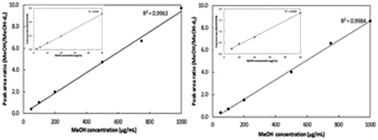Quantitative analysis of methanol in wastewater by GC-MS with direct injection or headspace SPME sample introduction
Abstract
Monitoring

* Corresponding authors
a
Department of Civil Engineering, The City College of New York, Room T-182, Steinman Hall 160 Convent Avenue, New York, USA
E-mail:
xxu3@ccny.cuny.edu
Fax: +1 212 650 6967
Tel: +1 212 650 7501
Monitoring

 Please wait while we load your content...
Something went wrong. Try again?
Please wait while we load your content...
Something went wrong. Try again?
X. Xu, J. Fillos, K. Ramalingam and A. Rosenthal, Anal. Methods, 2012, 4, 3688 DOI: 10.1039/C2AY25452B
To request permission to reproduce material from this article, please go to the Copyright Clearance Center request page.
If you are an author contributing to an RSC publication, you do not need to request permission provided correct acknowledgement is given.
If you are the author of this article, you do not need to request permission to reproduce figures and diagrams provided correct acknowledgement is given. If you want to reproduce the whole article in a third-party publication (excluding your thesis/dissertation for which permission is not required) please go to the Copyright Clearance Center request page.
Read more about how to correctly acknowledge RSC content.
 Fetching data from CrossRef.
Fetching data from CrossRef.
This may take some time to load.
Loading related content
